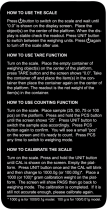Safety Information:
§ Please read these operating instructions
carefully before using your scale
to prevent damage to the equipment.
!Do not use this equipment in
hazardous areas.
!Use only standard cables that have
protective grounding conductors.
The protective conductor must not
be disconnected for any reason.
!Disconnect the scale from power before
connecting or disconnecting peripheral
devices.
!The scale may be opened only by
trained service technicians.
!If you operate the equipment under
ambient conditions subject to higher
safety standards, you must comply with
the applicable installation regulations.
!If there is visible damage to the
equipment or power cord, unplug the
equipment and make sure it cannot
be used for the time being.
!If you use electrical equipment in
installations and under ambient
conditions requiring higher safety
standards, you must comply with
the provisions as specified in the
applicable regulations for installation
in your country.
Installation:
– Proceed with extreme caution when
using pre-wired RS-232 connecting
cables from other manufacturers,
as the pin assignments may not be
compatible with Sartorius equipment.
Check all pin assignments against the
cabling diagrams and disconnect any
lines that are not assigned.
!Always wear gloves, safety boots and
protective clothing when lifting the
load plate with a vacuum lifting pad.
Danger of injury! This work may
be carried out only by authorized and
properly trained personnel.
– Weighing platforms with dimensions
larger than 1 x 1 m are provided with
suspension supports. Be careful not
to stand under the load when the
weighing platform/load plate is being
transported or lifted with a crane.
Always comply with the applicable
accident prevention regulations. Make
sure to avoid damaging the terminal
box and housing or the load cell during
transport.
– Connect only Sartorius accessories and
options, as these are optimally designed
for use with your Combics indicator.
The operator shall be solely responsible
for installation and testing of any
modifications to Sartorius equipment,
including connection of cables or
equipment not supplied by Sartorius.
Contact Sartorius for detailed operating
specifications in accordance with the
Standards for immunity to interference.
– Do not expose the indicator to
aggressive chemical vapors or to
extreme temperatures, moisture,
shocks, or vibration.
– Clean your Combics only in accordance
with the cleaning instructions (see “Care
and Maintenance”).
$ If you have any problems with your
Combics indicator, contact your local
Sartorius customer service center.
IP Rating:
– CW1P | CW1NP | CW2P | CH1NE
models are rated to IP44
(with option L1: IP65);
– CW1(F)S | CW1N(F)S | CH1NG |
CW2(F)S models are rated to IP67.
– The IP65/IP67 protection rating is
ensured only if the rubber gasket is
installed and all connections are
fastened securely (including the caps on
unused sockets). Weighing instruments
must be installed and tested by a
certified technician.
– If you install an interface port after
setting up your indicator, keep the
protective cap in a safe place for future
use. The cap protects the interface
connector from vapors, moisture and
dust or dirt.
Using the Equipment in Legal
Metrology in the EU*:
– When the indicator is connected to a
weighing instrument and the resulting
weighing instrument is to be verified,
make sure to observe the applicable
regulations regarding verification. When
connecting a Sartorius weighing instru-
ment, please observe the “Guide to
Verification" on the enclosed CD and
the permitted weighing range as listed
in the Declaration of Conformity.
– EU legislation requires that a control
seal be affixed to the verified device.
The control seal consists of a sticker
with the “Sartorius" logo. This seal will
be irreparably damaged if you attempt
to remove it. If any of the verification
seals are damaged, make sure to observe
the national regulations and standards
applicable in your country in such cases.
In some countries, the verification will
become null and void and the equip-
ment must be re-verified.
* Including the Signatories of the Agree-
ment on the European Economic Area
4
Warning and Safety Precautions
























